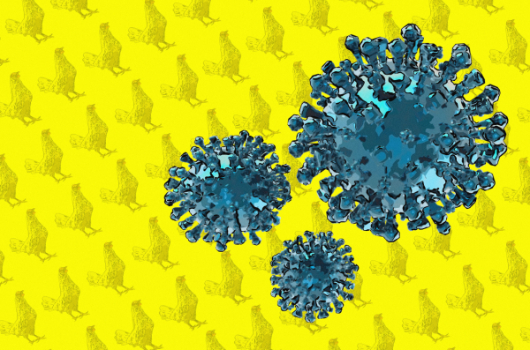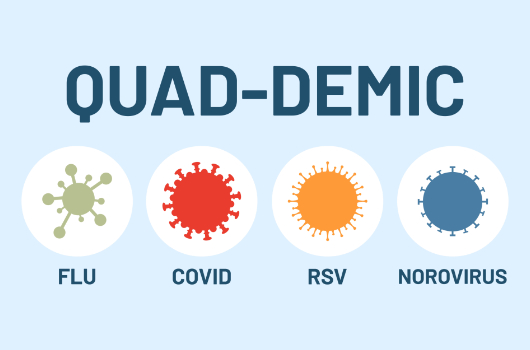Clinical Study
Latest Update on Antimicrobial Resistant Gonorrhea: Challenges and Control Measures

Dr. Pallavi Upadhyay • July 19, 2024
Originally published in: Infection Control Today
Complicated and untreatable gonococcal infections due to antimicrobial-resistant gonorrhea are outpacing the advancements and development of novel antibiotics and testing technologies.
Neisseria gonorrhoeae is the causal pathogen of gonorrhea (also known as gonococcal infections), which is among the most prominent sexually transmitted infections (STIs) worldwide.1
The history of gonorrhea is as ancient as the history of sexually transmitted diseases.1 Reference of gonorrhea and its treatment dates back to the sixteenth century, almost 2 centuries before the first identification of its causative agent (Neisseria gonorrhoeae).2
While over the centuries, various chemicals and drugs, from mercury to silver nitrate, were used to treat the gonococcal disease, the discovery of the etiologic agent Neisseria gonorrhoeae in 1879 was truly the turning point for gonorrhea antibiotics and vaccine research. The first antibacterials that were introduced to treat gonorrhea were sulfonamides (in 1937). Over the past 7 to 8 decades, an array of antibiotics has been introduced in the market as the ever-evolving bacteria continues to evade the antibiotics prescribed for treatment. When a pathogen stops responding to antibiotic treatment, this phenomenon is coined as antimicrobial resistance. The World Health Organization (WHO) recognizes antimicrobial resistance (AMR) as one of the significant global public health and development threats. In 2019, bacterial AMR accounted, directly and indirectly, for more than 4.5 million mortality cases worldwide.3
Despite increased awareness of routine sexually transmitted infection (STI) screening and testing, rates of gonorrhea infections have spiked steadily over the past several years.3 Some of the main reasons why gonococcal infections are still widespread and a significant public health concern are as follows:
Status of AMR Gonorrhea Infections
AMR is a biological phenomenon that takes place over several years, even decades, as the pathogen evolves naturally due to genetic alterations; however, some of the main factors that have impacted AMR strain’s emergence and spread are inappropriate to use (overuse, underuse, and unnecessary use) of antimicrobials; usage of ineffective/counterfeit antimicrobials with low or no efficacy; mutations in the genetic makeup of the causative organism.8
The recent COVID-19 pandemic exacerbated the spread of STIs, with lockdowns coupled with reduced access to STI screening and testing. More than 82 million gonorrhea infections were reported globally in the year 2020.9 The CDC estimates approximately 1.6 million new gonorrhea infections each year within the United States, and around 50% of these infections are resistant to at least one antimicrobial.10,11
AMR Gonorrhea surveillance studies conducted in other countries also report that most of the detected cases of Gonococcal infections are resistant to at least one of the antimicrobials if not all, of the recommended antibiotics (e.g., penicillin, tetracyclines, quinolones, etc).12,13 Currently, the CDC recommends ceftriaxone (a third-generation cephalosporin) as monotherapy for uncomplicated gonorrhea infections.14 However, recent studies that demonstrate the emergence of ceftriaxone-resistant gonorrhea strains are alarming, as ceftriaxone is considered the “last line” of effective antibiotic treatment for gonorrhea infections.15
Advancements in Gonorrhea infection prevention and control
There have been remarkable advancements in new technologies that bolster timely gonorrhea diagnosis, treatment, and control. Teamed with continuous surveillance, these advancements would be crucial to combat existing and emerging AMR gonorrhea strains.
I. Diagnostics: Traditional methods of gonorrhea diagnosis, which include microbial culture and microscopy, suffer from delayed turnaround time for results and low sensitivity. This has led to Nucleic Acid Amplification Test (NAAT)—based testing emerging as the new “gold standard” for diagnosing the disease, which can be asymptomatic for prolonged periods. However, the high cost associated with NAAT-based technologies can be a barrier to accessing these tests, especially in resource-limited settings.
Rapid diagnostics at the point of care (POC), with high sensitivity and specificity for the pathogen, can help alleviate many issues associated with increasing the availability and acceptability of STI testing. Binx Health io CT/NG (Chlamydia trachomatis and Neisseria gonorrhoeae) Assay was the first PCR-based test for gonorrhea diagnosis to receive FDA approval.16 Visby Medical Sexual Health Test is another POC test with FDA approval for the detection of gonorrhea in females.17 Recently, CARB-X has awarded $1.8 million to Visby Medical for the development of a portable PCR test that can detect ciprofloxacin susceptible gonorrhea infections, potentially allowing physicians to be more judicious in prescribing ceftriaxone, the last resort antibiotic against the pathogen.18 A new experimental POC platform using a PCR-based cartridge test for gonorrhea that demonstrated high sensitivity and specificity in clinical settings has been developed by Johns Hopkins University.19
The first FDA marketing authorization, in November 2023, for the Simple 2 test for at-home collection of specimens for chlamydia and gonorrhea testing marks a significant development in increasing access to these tests. Approved self-collection in the privacy of a non-clinical setting will further help in removing the barriers encountered in STI testing access.20
Earlier this year, a cross-sectional study performed in South Africa demonstrated very high clinical sensitivity and specificity for gonorrhea detection in both males and females using a low-cost lateral flow assay. With performance criteria comparable to PCR tests, this new test promises to improve gonorrhea disease management in settings where access to laboratory testing or POC devices may be limited.21
II. Prevention and Treatment: Research and development to find effective novel antimicrobials, alternative therapies, and vaccines have become imperative, especially within the landscape of AMR strains resistant to the first line of antimicrobial treatment. There are two promising antibiotic candidates, moxifloxacin and gepotidacin, in advanced clinical trial stages.22 While the development of effective vaccines against gonorrhea has presented challenges over the past several years, there are recent reports regarding promising vaccine candidates.23
III. Surveillance strategies: Infection tracking, tracing, and continuous surveillance remain some of the prime strategies of healthcare and public health sectors in controlling and preventing disease spread. Both WHO and CDC recognize AMR Gonorrhea as an urgent public health concern. To combat AMR gonorrhea, the WHO emphasizes not only controlling the drug resistance but also the causative pathogen by implementing a global action plan; some of the programs initiated by WHO towards surveillance are the WHO Global Antimicrobial Resistance and Use Surveillance System (GLASS); Global Gonococcal Antimicrobial Surveillance Program (GASP) and Enhanced Gonococcal Antimicrobial Surveillance Programme (EGASP).24 Within the US, the CDC is surveilling MDR gonorrhea via projects like the Gonococcal Isolate Surveillance Project (GISP), the enhanced Gonococcal Isolate Surveillance Project (eGISP), and Strengthening the United States Response to Resistant Gonorrhea (SURRG).25
Conclusion
Emerging AMR gonorrhea strains are one of the major health threats worldwide. While routine STI screening, clinician implementation, and adherence to antimicrobial stewardship programs are pivotal in curbing AMR strain emergence, advancements in diagnostics for timely detection and treatment and surveillance strategies to prevent infection spread should be at the forefront of our fight against AMR gonorrhea.
References
- Vicentini CB, Manfredini S, Maritati M, Di Nuzzo M, Contini C. Gonorrhea, a current disease with ancient roots: from the remedies of the past to future perspectives. Infez Med. 2019;27(2):212-221.
- Ligon BL. Albert Ludwig Sigesmund Neisser: discoverer of the cause of gonorrhea. Semin Pediatr Infect Dis. 2005;16(4):336-41. doi: 10.1053/j.spid.2005.07.001. PMID: 16210113.
- Antimicrobial Resistance. WHO. Updated Nov 21, 2023. Accessed May 26, 2024.
https://www.who.int/news-room/fact-sheets/detail/antimicrobial-resistance - Jarvis GA, Chang TL. Modulation of HIV transmission by Neisseria gonorrhoeae: molecular and immunological aspects. Curr HIV Res. 2012;10(3):211-217. doi: 10.2174/157016212800618138.
- Multi-drug resistant gonorrhoea. WHO. Published July 11, 2023. Accessed May 22, 2024.
https://www.who.int/news-room/fact-sheets/detail/multi-drug-resistant-gonorrhoea - Vallely LM, Egli-Gany D, Wand H, et al. Adverse pregnancy and neonatal outcomes associated with Neisseria gonorrhoeae: systematic review and meta-analysis. Sex Transm Infect. 2021;97(2):104-111. doi: 10.1136/sextrans-2020-054653.
- Kidd S, Workowski KA. Management of Gonorrhea in Adolescents and Adults in the United States. Clin Infect Dis. 2015;61 Suppl 8:S785-801. doi: 10.1093/cid/civ731.
- Castro-Sánchez E, Moore LS, Husson F, Holmes AH. What are the factors driving antimicrobial resistance? Perspectives from a public event in London, England. BMC Infect Dis. 2016;16(1):465. doi: 10.1186/s12879-016-1810-x.
- Gonorrhea (Neisseria gonorhoeae) infection. WHO. Published July 18, 2023. Accessed May 22, 2024.
https://www.who.int/news-room/fact-sheets/detail/gonorrhoea-(neisseria-gonorrhoeae-infection)#:~:text=In%202020%2C%20WHO%20estimated%2082.4,people%20in%20high%20burden%20countries - Gonococcal Infections Among Adolescents and Adults. CDC. Updated September 21, 2022. May 26, 2024.
https://www.cdc.gov/std/treatment-guidelines/gonorrhea-adults.htm - National Overview of STIs, 2022. CDC. Updated January 30, 2024. Accessed May 27, 2024.
https://www.cdc.gov/std/statistics/2022/overview.htm - Whittles LK, White PJ, Paul J, Didelot X. Epidemiological trends of antibiotic-resistant Gonorrhoea in the United Kingdom. Antibiotics (Basel). 2018;7(3):60. doi: 10.3390/antibiotics7030060.
- Unemo M, Del Rio C, Shafer WM. 2016. Antimicrobial Resistance Expressed by Neisseria gonorrhoeae: A Major Global Public Health Problem in the 21st Century. Microbiol Spectr. 2016;4(3):10. doi: 1128/microbiolspec.ei10-0009-2015
- St Cyr S, Barbee L, Workowski KA, et al. Update to CDC’s Treatment Guidelines for Gonococcal Infection, 2020. MMWR Morb Mortal Wkly Rep. 2020;69(50):1911-1916. doi: 10.15585/mmwr.mm6950a6.
- Zhu X, Xi Y, Gong X, Chen S. Ceftriaxone-Resistant Gonorrhea – China, 2022. MMWR Morb Mortal Wkly Rep. 2024;73(12):255-259. doi:10.15585/mmwr.mm7312a2.
- FDA Allows for First Point-of-Care Chlamydia and Gonorrhea Test to be Used in More Near-Patient Care Settings. FDA. Published March 30, 2021. Accessed May 22, 2024.
https://www.fda.gov/news-events/press-announcements/fda-allows-first-point-care-chlamydia-and-gonorrhea-test-be-used-more-near-patient-care-settings - Visby Medical™ Receives FDA Clearance and CLIA Waiver for Second Generation Sexual Health Test for Women. Visby Medical. Published March 14, 2023. Accessed May 27, 2024.
https://www.visbymedical.com/news/visby-medical-receives-fda-clearance-and-clia-waiver-for-second-generation-sexual-health-test-for-women/#:~:text=%E2%80%93%20March%2014%2C%202023%20%E2%80%93%20Visby,of%20care%20(POC)%20test - CARB-X funds Visby Medical to develop a portable rapid diagnostic for Gonorrhea, including antibiotic susceptibility. CARB-X.Published February 8, 2024. Accessed May 26, 2024.
https://carb-x.org/carb-x-news/carb-x-funds-visby-medical/ - Trick AY, Melendez JH, Chen FE, et al. A portable magnetofluidic platform for detecting sexually transmitted infections and antimicrobial susceptibility. Sci Transl Med. 2021;13(593):eabf6356. doi: 10.1126/scitranslmed.abf6356.
- FDA grants marketing authorization of the first test for Chlamydia and Gonorrhea with at-home sample collection. FDA. Published November 15, 2023. Accessed May 26, 2024.
https://www.fda.gov/news-events/press-announcements/fda-grants-marketing-authorization-first-test-chlamydia-and-gonorrhea-home-sample-collection - Peters RPH, Klausner JD, Mazzola L, et al. Novel lateral flow assay for point-of-care detection of Neisseria gonorrhoeae infection in syndromic management settings: a cross-sectional performance evaluation. Lancet. 2024;403(10427):657-664. doi: 10.1016/S0140-6736(23)02240-7.
- Raccagni AR, Ranzenigo M, Bruzzesi E, Maci C, Castagna A, Nozza S. Neisseria gonorrhoeae antimicrobial resistance: the future of antibiotic therapy. J Clin Med. 2023;12(24):7767. doi: 10.3390/jcm12247767.
- Johnson B. GSK’s gonorrhea vaccine receives fast-track designation to expedite clinical trials. Nat Med. 2023;29(9):2146-2147. doi: 10.1038/d41591-023-00069-9.
- Unemo M, Lahra MM, Cole M, et al. World Health Organization global gonococcal antimicrobial surveillance program (WHO GASP): review of new data and evidence to inform international collaborative actions and research efforts. Sex Health. 2019;16(5):412-425. doi: 10.1071/SH19023
- Drug-resistant gonorrhea. CDC. Updated February 15, 2024, Accessed May 24, 2024.
https://www.cdc.gov/gonorrhea/hcp/drug-resistant/?CDC_AAref_Val=https://www.cdc.gov/std/gonorrhea/drug-resistant/basic.htm
References
- Vicentini CB, Manfredini S, Maritati M, Di Nuzzo M, Contini C. Gonorrhea, a current disease with ancient roots: from the remedies of the past to future perspectives. Infez Med. 2019;27(2):212-221.
- Ligon BL. Albert Ludwig Sigesmund Neisser: discoverer of the cause of gonorrhea. Semin Pediatr Infect Dis. 2005;16(4):336-41. doi: 10.1053/j.spid.2005.07.001. PMID: 16210113.
- Antimicrobial Resistance. WHO. Updated Nov 21, 2023. Accessed May 26, 2024.
https://www.who.int/news-room/fact-sheets/detail/antimicrobial-resistance - Jarvis GA, Chang TL. Modulation of HIV transmission by Neisseria gonorrhoeae: molecular and immunological aspects. Curr HIV Res. 2012;10(3):211-217. doi: 10.2174/157016212800618138.
- Multi-drug resistant gonorrhoea. WHO. Published July 11, 2023. Accessed May 22, 2024.
https://www.who.int/news-room/fact-sheets/detail/multi-drug-resistant-gonorrhoea - Vallely LM, Egli-Gany D, Wand H, et al. Adverse pregnancy and neonatal outcomes associated with Neisseria gonorrhoeae: systematic review and meta-analysis. Sex Transm Infect. 2021;97(2):104-111. doi: 10.1136/sextrans-2020-054653.
- Kidd S, Workowski KA. Management of Gonorrhea in Adolescents and Adults in the United States. Clin Infect Dis. 2015;61 Suppl 8:S785-801. doi: 10.1093/cid/civ731.
- Castro-Sánchez E, Moore LS, Husson F, Holmes AH. What are the factors driving antimicrobial resistance? Perspectives from a public event in London, England. BMC Infect Dis. 2016;16(1):465. doi: 10.1186/s12879-016-1810-x.
- Gonorrhea (Neisseria gonorhoeae) infection. WHO. Published July 18, 2023. Accessed May 22, 2024.
https://www.who.int/news-room/fact-sheets/detail/gonorrhoea-(neisseria-gonorrhoeae-infection)#:~:text=In%202020%2C%20WHO%20estimated%2082.4,people%20in%20high%20burden%20countries - Gonococcal Infections Among Adolescents and Adults. CDC. Updated September 21, 2022. May 26, 2024.
https://www.cdc.gov/std/treatment-guidelines/gonorrhea-adults.htm - National Overview of STIs, 2022. CDC. Updated January 30, 2024. Accessed May 27, 2024.
https://www.cdc.gov/std/statistics/2022/overview.htm - Whittles LK, White PJ, Paul J, Didelot X. Epidemiological trends of antibiotic-resistant Gonorrhoea in the United Kingdom. Antibiotics (Basel). 2018;7(3):60. doi: 10.3390/antibiotics7030060.
- Unemo M, Del Rio C, Shafer WM. 2016. Antimicrobial Resistance Expressed by Neisseria gonorrhoeae: A Major Global Public Health Problem in the 21st Century. Microbiol Spectr. 2016;4(3):10. doi: 1128/microbiolspec.ei10-0009-2015
- St Cyr S, Barbee L, Workowski KA, et al. Update to CDC’s Treatment Guidelines for Gonococcal Infection, 2020. MMWR Morb Mortal Wkly Rep. 2020;69(50):1911-1916. doi: 10.15585/mmwr.mm6950a6.
- Zhu X, Xi Y, Gong X, Chen S. Ceftriaxone-Resistant Gonorrhea – China, 2022. MMWR Morb Mortal Wkly Rep. 2024;73(12):255-259. doi:10.15585/mmwr.mm7312a2.
- FDA Allows for First Point-of-Care Chlamydia and Gonorrhea Test to be Used in More Near-Patient Care Settings. FDA. Published March 30, 2021. Accessed May 22, 2024.
https://www.fda.gov/news-events/press-announcements/fda-allows-first-point-care-chlamydia-and-gonorrhea-test-be-used-more-near-patient-care-settings - Visby Medical™ Receives FDA Clearance and CLIA Waiver for Second Generation Sexual Health Test for Women. Visby Medical. Published March 14, 2023. Accessed May 27, 2024.
https://www.visbymedical.com/news/visby-medical-receives-fda-clearance-and-clia-waiver-for-second-generation-sexual-health-test-for-women/#:~:text=%E2%80%93%20March%2014%2C%202023%20%E2%80%93%20Visby,of%20care%20(POC)%20test - CARB-X funds Visby Medical to develop a portable rapid diagnostic for Gonorrhea, including antibiotic susceptibility. CARB-X.Published February 8, 2024. Accessed May 26, 2024.
https://carb-x.org/carb-x-news/carb-x-funds-visby-medical/ - Trick AY, Melendez JH, Chen FE, et al. A portable magnetofluidic platform for detecting sexually transmitted infections and antimicrobial susceptibility. Sci Transl Med. 2021;13(593):eabf6356. doi: 10.1126/scitranslmed.abf6356.
- FDA grants marketing authorization of the first test for Chlamydia and Gonorrhea with at-home sample collection. FDA. Published November 15, 2023. Accessed May 26, 2024.
https://www.fda.gov/news-events/press-announcements/fda-grants-marketing-authorization-first-test-chlamydia-and-gonorrhea-home-sample-collection - Peters RPH, Klausner JD, Mazzola L, et al. Novel lateral flow assay for point-of-care detection of Neisseria gonorrhoeae infection in syndromic management settings: a cross-sectional performance evaluation. Lancet. 2024;403(10427):657-664. doi: 10.1016/S0140-6736(23)02240-7.
- Raccagni AR, Ranzenigo M, Bruzzesi E, Maci C, Castagna A, Nozza S. Neisseria gonorrhoeae antimicrobial resistance: the future of antibiotic therapy. J Clin Med. 2023;12(24):7767. doi: 10.3390/jcm12247767.
- Johnson B. GSK’s gonorrhea vaccine receives fast-track designation to expedite clinical trials. Nat Med. 2023;29(9):2146-2147. doi: 10.1038/d41591-023-00069-9.
- Unemo M, Lahra MM, Cole M, et al. World Health Organization global gonococcal antimicrobial surveillance program (WHO GASP): review of new data and evidence to inform international collaborative actions and research efforts. Sex Health. 2019;16(5):412-425. doi: 10.1071/SH19023
- Drug-resistant gonorrhea. CDC. Updated February 15, 2024, Accessed May 24, 2024.
https://www.cdc.gov/gonorrhea/hcp/drug-resistant/?CDC_AAref_Val=https://www.cdc.gov/std/gonorrhea/drug-resistant/basic.htm
Related Articles and White papers

Dr. Pallavi Upadhyay • July 19, 2024
Originally published in: Infection Control Today
Complicated and untreatable gonococcal infections due to antimicrobial-resistant gonorrhea are outpacing the advancements and development of novel antibiotics and testing technologies.
Neisseria gonorrhoeae is the causal pathogen of gonorrhea (also known as gonococcal infections), which is among the most prominent sexually transmitted infections (STIs) worldwide.1
The history of gonorrhea is as ancient as the history of sexually transmitted diseases.1 Reference of gonorrhea and its treatment dates back to the sixteenth century, almost 2 centuries before the first identification of its causative agent (Neisseria gonorrhoeae).2
While over the centuries, various chemicals and drugs, from mercury to silver nitrate, were used to treat the gonococcal disease, the discovery of the etiologic agent Neisseria gonorrhoeae in 1879 was truly the turning point for gonorrhea antibiotics and vaccine research. The first antibacterials that were introduced to treat gonorrhea were sulfonamides (in 1937). Over the past 7 to 8 decades, an array of antibiotics has been introduced in the market as the ever-evolving bacteria continues to evade the antibiotics prescribed for treatment. When a pathogen stops responding to antibiotic treatment, this phenomenon is coined as antimicrobial resistance. The World Health Organization (WHO) recognizes antimicrobial resistance (AMR) as one of the significant global public health and development threats. In 2019, bacterial AMR accounted, directly and indirectly, for more than 4.5 million mortality cases worldwide.3
Despite increased awareness of routine sexually transmitted infection (STI) screening and testing, rates of gonorrhea infections have spiked steadily over the past several years.3 Some of the main reasons why gonococcal infections are still widespread and a significant public health concern are as follows:
Status of AMR Gonorrhea Infections
AMR is a biological phenomenon that takes place over several years, even decades, as the pathogen evolves naturally due to genetic alterations; however, some of the main factors that have impacted AMR strain’s emergence and spread are inappropriate to use (overuse, underuse, and unnecessary use) of antimicrobials; usage of ineffective/counterfeit antimicrobials with low or no efficacy; mutations in the genetic makeup of the causative organism.8
The recent COVID-19 pandemic exacerbated the spread of STIs, with lockdowns coupled with reduced access to STI screening and testing. More than 82 million gonorrhea infections were reported globally in the year 2020.9 The CDC estimates approximately 1.6 million new gonorrhea infections each year within the United States, and around 50% of these infections are resistant to at least one antimicrobial.10,11
AMR Gonorrhea surveillance studies conducted in other countries also report that most of the detected cases of Gonococcal infections are resistant to at least one of the antimicrobials if not all, of the recommended antibiotics (e.g., penicillin, tetracyclines, quinolones, etc).12,13 Currently, the CDC recommends ceftriaxone (a third-generation cephalosporin) as monotherapy for uncomplicated gonorrhea infections.14 However, recent studies that demonstrate the emergence of ceftriaxone-resistant gonorrhea strains are alarming, as ceftriaxone is considered the “last line” of effective antibiotic treatment for gonorrhea infections.15
Advancements in Gonorrhea infection prevention and control
There have been remarkable advancements in new technologies that bolster timely gonorrhea diagnosis, treatment, and control. Teamed with continuous surveillance, these advancements would be crucial to combat existing and emerging AMR gonorrhea strains.
I. Diagnostics: Traditional methods of gonorrhea diagnosis, which include microbial culture and microscopy, suffer from delayed turnaround time for results and low sensitivity. This has led to Nucleic Acid Amplification Test (NAAT)—based testing emerging as the new “gold standard” for diagnosing the disease, which can be asymptomatic for prolonged periods. However, the high cost associated with NAAT-based technologies can be a barrier to accessing these tests, especially in resource-limited settings.
Rapid diagnostics at the point of care (POC), with high sensitivity and specificity for the pathogen, can help alleviate many issues associated with increasing the availability and acceptability of STI testing. Binx Health io CT/NG (Chlamydia trachomatis and Neisseria gonorrhoeae) Assay was the first PCR-based test for gonorrhea diagnosis to receive FDA approval.16 Visby Medical Sexual Health Test is another POC test with FDA approval for the detection of gonorrhea in females.17 Recently, CARB-X has awarded $1.8 million to Visby Medical for the development of a portable PCR test that can detect ciprofloxacin susceptible gonorrhea infections, potentially allowing physicians to be more judicious in prescribing ceftriaxone, the last resort antibiotic against the pathogen.18 A new experimental POC platform using a PCR-based cartridge test for gonorrhea that demonstrated high sensitivity and specificity in clinical settings has been developed by Johns Hopkins University.19
The first FDA marketing authorization, in November 2023, for the Simple 2 test for at-home collection of specimens for chlamydia and gonorrhea testing marks a significant development in increasing access to these tests. Approved self-collection in the privacy of a non-clinical setting will further help in removing the barriers encountered in STI testing access.20
Earlier this year, a cross-sectional study performed in South Africa demonstrated very high clinical sensitivity and specificity for gonorrhea detection in both males and females using a low-cost lateral flow assay. With performance criteria comparable to PCR tests, this new test promises to improve gonorrhea disease management in settings where access to laboratory testing or POC devices may be limited.21
II. Prevention and Treatment: Research and development to find effective novel antimicrobials, alternative therapies, and vaccines have become imperative, especially within the landscape of AMR strains resistant to the first line of antimicrobial treatment. There are two promising antibiotic candidates, moxifloxacin and gepotidacin, in advanced clinical trial stages.22 While the development of effective vaccines against gonorrhea has presented challenges over the past several years, there are recent reports regarding promising vaccine candidates.23
III. Surveillance strategies: Infection tracking, tracing, and continuous surveillance remain some of the prime strategies of healthcare and public health sectors in controlling and preventing disease spread. Both WHO and CDC recognize AMR Gonorrhea as an urgent public health concern. To combat AMR gonorrhea, the WHO emphasizes not only controlling the drug resistance but also the causative pathogen by implementing a global action plan; some of the programs initiated by WHO towards surveillance are the WHO Global Antimicrobial Resistance and Use Surveillance System (GLASS); Global Gonococcal Antimicrobial Surveillance Program (GASP) and Enhanced Gonococcal Antimicrobial Surveillance Programme (EGASP).24 Within the US, the CDC is surveilling MDR gonorrhea via projects like the Gonococcal Isolate Surveillance Project (GISP), the enhanced Gonococcal Isolate Surveillance Project (eGISP), and Strengthening the United States Response to Resistant Gonorrhea (SURRG).25
Conclusion
Emerging AMR gonorrhea strains are one of the major health threats worldwide. While routine STI screening, clinician implementation, and adherence to antimicrobial stewardship programs are pivotal in curbing AMR strain emergence, advancements in diagnostics for timely detection and treatment and surveillance strategies to prevent infection spread should be at the forefront of our fight against AMR gonorrhea.
References
- Vicentini CB, Manfredini S, Maritati M, Di Nuzzo M, Contini C. Gonorrhea, a current disease with ancient roots: from the remedies of the past to future perspectives. Infez Med. 2019;27(2):212-221.
- Ligon BL. Albert Ludwig Sigesmund Neisser: discoverer of the cause of gonorrhea. Semin Pediatr Infect Dis. 2005;16(4):336-41. doi: 10.1053/j.spid.2005.07.001. PMID: 16210113.
- Antimicrobial Resistance. WHO. Updated Nov 21, 2023. Accessed May 26, 2024.
https://www.who.int/news-room/fact-sheets/detail/antimicrobial-resistance - Jarvis GA, Chang TL. Modulation of HIV transmission by Neisseria gonorrhoeae: molecular and immunological aspects. Curr HIV Res. 2012;10(3):211-217. doi: 10.2174/157016212800618138.
- Multi-drug resistant gonorrhoea. WHO. Published July 11, 2023. Accessed May 22, 2024.
https://www.who.int/news-room/fact-sheets/detail/multi-drug-resistant-gonorrhoea - Vallely LM, Egli-Gany D, Wand H, et al. Adverse pregnancy and neonatal outcomes associated with Neisseria gonorrhoeae: systematic review and meta-analysis. Sex Transm Infect. 2021;97(2):104-111. doi: 10.1136/sextrans-2020-054653.
- Kidd S, Workowski KA. Management of Gonorrhea in Adolescents and Adults in the United States. Clin Infect Dis. 2015;61 Suppl 8:S785-801. doi: 10.1093/cid/civ731.
- Castro-Sánchez E, Moore LS, Husson F, Holmes AH. What are the factors driving antimicrobial resistance? Perspectives from a public event in London, England. BMC Infect Dis. 2016;16(1):465. doi: 10.1186/s12879-016-1810-x.
- Gonorrhea (Neisseria gonorhoeae) infection. WHO. Published July 18, 2023. Accessed May 22, 2024.
https://www.who.int/news-room/fact-sheets/detail/gonorrhoea-(neisseria-gonorrhoeae-infection)#:~:text=In%202020%2C%20WHO%20estimated%2082.4,people%20in%20high%20burden%20countries - Gonococcal Infections Among Adolescents and Adults. CDC. Updated September 21, 2022. May 26, 2024.
https://www.cdc.gov/std/treatment-guidelines/gonorrhea-adults.htm - National Overview of STIs, 2022. CDC. Updated January 30, 2024. Accessed May 27, 2024.
https://www.cdc.gov/std/statistics/2022/overview.htm - Whittles LK, White PJ, Paul J, Didelot X. Epidemiological trends of antibiotic-resistant Gonorrhoea in the United Kingdom. Antibiotics (Basel). 2018;7(3):60. doi: 10.3390/antibiotics7030060.
- Unemo M, Del Rio C, Shafer WM. 2016. Antimicrobial Resistance Expressed by Neisseria gonorrhoeae: A Major Global Public Health Problem in the 21st Century. Microbiol Spectr. 2016;4(3):10. doi: 1128/microbiolspec.ei10-0009-2015
- St Cyr S, Barbee L, Workowski KA, et al. Update to CDC’s Treatment Guidelines for Gonococcal Infection, 2020. MMWR Morb Mortal Wkly Rep. 2020;69(50):1911-1916. doi: 10.15585/mmwr.mm6950a6.
- Zhu X, Xi Y, Gong X, Chen S. Ceftriaxone-Resistant Gonorrhea – China, 2022. MMWR Morb Mortal Wkly Rep. 2024;73(12):255-259. doi:10.15585/mmwr.mm7312a2.
- FDA Allows for First Point-of-Care Chlamydia and Gonorrhea Test to be Used in More Near-Patient Care Settings. FDA. Published March 30, 2021. Accessed May 22, 2024.
https://www.fda.gov/news-events/press-announcements/fda-allows-first-point-care-chlamydia-and-gonorrhea-test-be-used-more-near-patient-care-settings - Visby Medical™ Receives FDA Clearance and CLIA Waiver for Second Generation Sexual Health Test for Women. Visby Medical. Published March 14, 2023. Accessed May 27, 2024.
https://www.visbymedical.com/news/visby-medical-receives-fda-clearance-and-clia-waiver-for-second-generation-sexual-health-test-for-women/#:~:text=%E2%80%93%20March%2014%2C%202023%20%E2%80%93%20Visby,of%20care%20(POC)%20test - CARB-X funds Visby Medical to develop a portable rapid diagnostic for Gonorrhea, including antibiotic susceptibility. CARB-X.Published February 8, 2024. Accessed May 26, 2024.
https://carb-x.org/carb-x-news/carb-x-funds-visby-medical/ - Trick AY, Melendez JH, Chen FE, et al. A portable magnetofluidic platform for detecting sexually transmitted infections and antimicrobial susceptibility. Sci Transl Med. 2021;13(593):eabf6356. doi: 10.1126/scitranslmed.abf6356.
- FDA grants marketing authorization of the first test for Chlamydia and Gonorrhea with at-home sample collection. FDA. Published November 15, 2023. Accessed May 26, 2024.
https://www.fda.gov/news-events/press-announcements/fda-grants-marketing-authorization-first-test-chlamydia-and-gonorrhea-home-sample-collection - Peters RPH, Klausner JD, Mazzola L, et al. Novel lateral flow assay for point-of-care detection of Neisseria gonorrhoeae infection in syndromic management settings: a cross-sectional performance evaluation. Lancet. 2024;403(10427):657-664. doi: 10.1016/S0140-6736(23)02240-7.
- Raccagni AR, Ranzenigo M, Bruzzesi E, Maci C, Castagna A, Nozza S. Neisseria gonorrhoeae antimicrobial resistance: the future of antibiotic therapy. J Clin Med. 2023;12(24):7767. doi: 10.3390/jcm12247767.
- Johnson B. GSK’s gonorrhea vaccine receives fast-track designation to expedite clinical trials. Nat Med. 2023;29(9):2146-2147. doi: 10.1038/d41591-023-00069-9.
- Unemo M, Lahra MM, Cole M, et al. World Health Organization global gonococcal antimicrobial surveillance program (WHO GASP): review of new data and evidence to inform international collaborative actions and research efforts. Sex Health. 2019;16(5):412-425. doi: 10.1071/SH19023
- Drug-resistant gonorrhea. CDC. Updated February 15, 2024, Accessed May 24, 2024.
https://www.cdc.gov/gonorrhea/hcp/drug-resistant/?CDC_AAref_Val=https://www.cdc.gov/std/gonorrhea/drug-resistant/basic.htm
References
- Vicentini CB, Manfredini S, Maritati M, Di Nuzzo M, Contini C. Gonorrhea, a current disease with ancient roots: from the remedies of the past to future perspectives. Infez Med. 2019;27(2):212-221.
- Ligon BL. Albert Ludwig Sigesmund Neisser: discoverer of the cause of gonorrhea. Semin Pediatr Infect Dis. 2005;16(4):336-41. doi: 10.1053/j.spid.2005.07.001. PMID: 16210113.
- Antimicrobial Resistance. WHO. Updated Nov 21, 2023. Accessed May 26, 2024.
https://www.who.int/news-room/fact-sheets/detail/antimicrobial-resistance - Jarvis GA, Chang TL. Modulation of HIV transmission by Neisseria gonorrhoeae: molecular and immunological aspects. Curr HIV Res. 2012;10(3):211-217. doi: 10.2174/157016212800618138.
- Multi-drug resistant gonorrhoea. WHO. Published July 11, 2023. Accessed May 22, 2024.
https://www.who.int/news-room/fact-sheets/detail/multi-drug-resistant-gonorrhoea - Vallely LM, Egli-Gany D, Wand H, et al. Adverse pregnancy and neonatal outcomes associated with Neisseria gonorrhoeae: systematic review and meta-analysis. Sex Transm Infect. 2021;97(2):104-111. doi: 10.1136/sextrans-2020-054653.
- Kidd S, Workowski KA. Management of Gonorrhea in Adolescents and Adults in the United States. Clin Infect Dis. 2015;61 Suppl 8:S785-801. doi: 10.1093/cid/civ731.
- Castro-Sánchez E, Moore LS, Husson F, Holmes AH. What are the factors driving antimicrobial resistance? Perspectives from a public event in London, England. BMC Infect Dis. 2016;16(1):465. doi: 10.1186/s12879-016-1810-x.
- Gonorrhea (Neisseria gonorhoeae) infection. WHO. Published July 18, 2023. Accessed May 22, 2024.
https://www.who.int/news-room/fact-sheets/detail/gonorrhoea-(neisseria-gonorrhoeae-infection)#:~:text=In%202020%2C%20WHO%20estimated%2082.4,people%20in%20high%20burden%20countries - Gonococcal Infections Among Adolescents and Adults. CDC. Updated September 21, 2022. May 26, 2024.
https://www.cdc.gov/std/treatment-guidelines/gonorrhea-adults.htm - National Overview of STIs, 2022. CDC. Updated January 30, 2024. Accessed May 27, 2024.
https://www.cdc.gov/std/statistics/2022/overview.htm - Whittles LK, White PJ, Paul J, Didelot X. Epidemiological trends of antibiotic-resistant Gonorrhoea in the United Kingdom. Antibiotics (Basel). 2018;7(3):60. doi: 10.3390/antibiotics7030060.
- Unemo M, Del Rio C, Shafer WM. 2016. Antimicrobial Resistance Expressed by Neisseria gonorrhoeae: A Major Global Public Health Problem in the 21st Century. Microbiol Spectr. 2016;4(3):10. doi: 1128/microbiolspec.ei10-0009-2015
- St Cyr S, Barbee L, Workowski KA, et al. Update to CDC’s Treatment Guidelines for Gonococcal Infection, 2020. MMWR Morb Mortal Wkly Rep. 2020;69(50):1911-1916. doi: 10.15585/mmwr.mm6950a6.
- Zhu X, Xi Y, Gong X, Chen S. Ceftriaxone-Resistant Gonorrhea – China, 2022. MMWR Morb Mortal Wkly Rep. 2024;73(12):255-259. doi:10.15585/mmwr.mm7312a2.
- FDA Allows for First Point-of-Care Chlamydia and Gonorrhea Test to be Used in More Near-Patient Care Settings. FDA. Published March 30, 2021. Accessed May 22, 2024.
https://www.fda.gov/news-events/press-announcements/fda-allows-first-point-care-chlamydia-and-gonorrhea-test-be-used-more-near-patient-care-settings - Visby Medical™ Receives FDA Clearance and CLIA Waiver for Second Generation Sexual Health Test for Women. Visby Medical. Published March 14, 2023. Accessed May 27, 2024.
https://www.visbymedical.com/news/visby-medical-receives-fda-clearance-and-clia-waiver-for-second-generation-sexual-health-test-for-women/#:~:text=%E2%80%93%20March%2014%2C%202023%20%E2%80%93%20Visby,of%20care%20(POC)%20test - CARB-X funds Visby Medical to develop a portable rapid diagnostic for Gonorrhea, including antibiotic susceptibility. CARB-X.Published February 8, 2024. Accessed May 26, 2024.
https://carb-x.org/carb-x-news/carb-x-funds-visby-medical/ - Trick AY, Melendez JH, Chen FE, et al. A portable magnetofluidic platform for detecting sexually transmitted infections and antimicrobial susceptibility. Sci Transl Med. 2021;13(593):eabf6356. doi: 10.1126/scitranslmed.abf6356.
- FDA grants marketing authorization of the first test for Chlamydia and Gonorrhea with at-home sample collection. FDA. Published November 15, 2023. Accessed May 26, 2024.
https://www.fda.gov/news-events/press-announcements/fda-grants-marketing-authorization-first-test-chlamydia-and-gonorrhea-home-sample-collection - Peters RPH, Klausner JD, Mazzola L, et al. Novel lateral flow assay for point-of-care detection of Neisseria gonorrhoeae infection in syndromic management settings: a cross-sectional performance evaluation. Lancet. 2024;403(10427):657-664. doi: 10.1016/S0140-6736(23)02240-7.
- Raccagni AR, Ranzenigo M, Bruzzesi E, Maci C, Castagna A, Nozza S. Neisseria gonorrhoeae antimicrobial resistance: the future of antibiotic therapy. J Clin Med. 2023;12(24):7767. doi: 10.3390/jcm12247767.
- Johnson B. GSK’s gonorrhea vaccine receives fast-track designation to expedite clinical trials. Nat Med. 2023;29(9):2146-2147. doi: 10.1038/d41591-023-00069-9.
- Unemo M, Lahra MM, Cole M, et al. World Health Organization global gonococcal antimicrobial surveillance program (WHO GASP): review of new data and evidence to inform international collaborative actions and research efforts. Sex Health. 2019;16(5):412-425. doi: 10.1071/SH19023
- Drug-resistant gonorrhea. CDC. Updated February 15, 2024, Accessed May 24, 2024.
https://www.cdc.gov/gonorrhea/hcp/drug-resistant/?CDC_AAref_Val=https://www.cdc.gov/std/gonorrhea/drug-resistant/basic.htm





